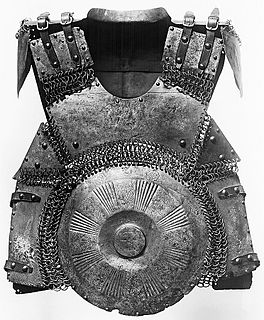 W
WA brigandine is a form of body armour from the Middle Ages. It is a garment typically made of heavy cloth, canvas or leather, lined internally with small oblong steel plates riveted to the fabric, sometimes with a second layer of fabric on the inside.
 W
WThe Clibanarii or Klibanophoroi, in Persian Grivpanvar, were a Sasanian Persian, late Roman and Byzantine military unit of armored heavy cavalry.
 W
WArmour in the Indian subcontinent was used since antiquity. Its earlier reference is found in the vedic period. Armour has been described in religious texts; including the Itihasa epics Ramayana and Mahabharat, as well as in the Puranas.
 W
WJazerant (Jaz´er`ant), or Hauberk jazerant, is a form of medieval light coat of armour consisting of mail between layers of fabric or leather. It was largely used in Turkey, the Middle East and Persia from the 11th and 12th century, at the end of the 13th and throughout the 14th century. In the following centuries, its use was replaced by that of the jaque, or "jacket", which was a kind of gambeson. Also known as Kazaghand, Gazarant or Gesserant, its name has been variously interpreted but most likely derives from the Arabic Jacerina, which means Algerine. The Arabs of north Africa were renowned for their mail coats. The samurai of Japan used a type of jazerant during the Edo period; kusari katabira were constructed with mail sewn between layers of cloth.
 W
WLaminar armour is an armour made from horizontal overlapping rows or bands of solid armour plates called lames, as opposed to lamellar armour, which is made from individual armor scales laced together to form a solid-looking strip of armor. Prominent examples of such armour are lorica segmentata of Ancient Rome and certain versions of samurai armour.
 W
WMail and plate armour is a type of mail with embedded plates. Armour of this type has been used in the Middle East, North Africa, Ottoman Empire, Japan, China, Korea, Vietnam, Central Asia, Greater Iran, India, Eastern Europe, and Nusantara.
 W
WMirror armour, sometimes referred to as disc armour or as chahār-āyneh or char-aina, was a type of cuirass used mainly in Asia, the Middle East, and Eastern Europe; including Indian, Persia, Tibet, Russia, and the Ottoman Empire. It literally translates to "four mirrors" which is a reflection of how these pieces looked, which resembles four metal discs or rectangular armour plates. Mirror armor was used in some cultures up to the 20th century.
 W
WMyeonje baegab (면제배갑, 綿製背甲) was a soft bulletproof vest invented in 1867 in the Joseon dynasty.